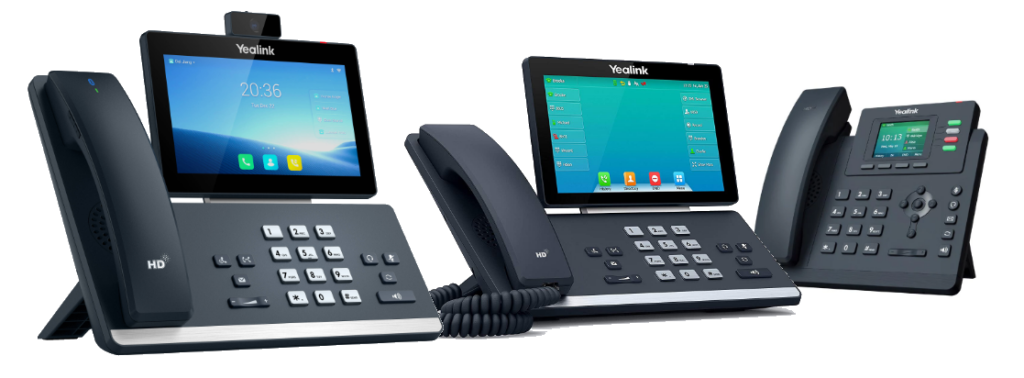
Michigan VoIP Phone Service Providers
Learn Why WaTech’s VoIP Phones Provide More While Costing Less
Whether it’s the first time or the thousandth time a customer calls you, your business needs a phone system that’s clear, reliable, and provides the services you need.
WaTech’s Alpha Voice VoIP phone systems go beyond the basics, offering full-featured systems with affordable pricing, advanced customization, and right-now support.
With our VoIP phone systems, your customers can always reach you, your team can easily communicate, and your business can stay connected to the world.

What is VoIP?
Instead of traditional copper phone line technology that dates back to the 19th century, VoIP (Voice Over Internet Protocol) uses an internet connection to place and receive calls.
Not only that, but VoIP phone systems also utilize advanced technology in many other ways, offering advantages to businesses like yours.
These VoIP phone advantages include:
- Lower costs
- Greater scalability
- More features
- Higher flexibility
However, not all VoIP systems and services are created equal.
For example, some VoIP providers will nickel-and-dime you for every feature, which can make utilizing the full advantages offered by VoIP phone systems cost-prohibitive.
Other providers don’t use the best servers to host their systems, which can lead to connectivity problems, poor call quality issues, or unreliable service.
Still others are happy to accept payment to set up a VoIP system, but then have poor customer service that doesn’t provide solutions when problems arise.
But that’s why WaTech Alpha Voice VoIP phone systems are different.
We make sure your VoIP phone system:
- Utilizes the latest networks across the US for a reliable, stable, crystal-clear call
- Is properly set up for your unique business, which includes utilizing the right features for you and is fully compatible with your IT infrastructure
- Gets any glitches fixed fast by our local help desk professionals who know your business and your systems
- Only includes the features you need
Who Benefits from our VoIP Phone Services
WaTech treats you as an individual, not a number.
That’s why we ensure your unique needs are met with your VoIP phone system, no matter the type or size of your business.
Our VoIP business clients include:
- Law firms and accounting offices
- Healthcare providers and clinics
- Remote teams and hybrid workforces
- Nonprofits and educational institutions
- Manufacturers and logistics operations
- Retail and service-based companies
Don’t see your sector listed above? Don’t worry.
We’ll work with you to build a phone system that meets your needs today while being fully capable of scaling to handle tomorrow’s growth.
How Our Fair, Transparent VoIP Saves You Money Each Month
Sadly, some VoIP providers want to hook you with low introductory rates, but then pile on extra charges or hidden fees once you sign up with them.
For example, they may tack on extra charges for more minutes of talk time, extra features, or for the additional devices you need.
However, WaTech doesn’t believe you need deep pockets to have a VoIP phone system that’s right for your business, nor do we need to trick you into signing a contract with us.
Instead, we know that you’ll choose us over the competition once you realize how much better our VoIP phone systems are compared to theirs.
And because we have a direct relationship with Yealink as our phone system vendor, we’re able to provide specialized features for your specific needs, and for the lowest possible price.
WaTech VoIP provides:
Low monthly pricing
With WaTech, your business is NOT charged for each phone set or phone line you have.
Instead, our VoIP billing is based on the peak number of simultaneous calls made and the number of external phone numbers you need, providing the lowest pricing structure available.
The right features for you, all included
With us, there are no separately priced modules, plug-ins, add-ons, licensing, or upcharges for any feature of our VoIP phone platform.
That means you get to use any feature you need from the initial install without paying any additional charges. We can also add additional features or advanced functionality to provide VoIP phone systems that grow with you.
Talk as long as you want
With WaTech, your team can talk as long as they want without having to pay more. This lets your team provide the highest level of service and customer care without worrying about racking up a higher bill.
All the VoIP Features You Want — No Strings Attached
Whether you have a small office or a multi-site operation, you can get a VoIP phone system that includes everything your business needs from WaTech.
Our VoIP phone features include:
- Auto-attendant (IVR)
- Mobile and desktop apps
- Voicemail to email or text message transcription
- Custom greetings and hold music
- Call recording
- Conference calling
- Call forwarding and transferring
- Ring groups and hunt groups
- Time-of-day routing
- Do Not Disturb
- Call status display
These are just some of the features offered by WaTech. But if you need something else, our VoIP technicians know exactly how to deliver it for unparalleled communication abilities.
Use Your Device with Our VoIP Service Via Our App
Sometimes improving efficiency and convenience means not changing certain things, like the device you already know and prefer using.
That’s why WaTech has built our exclusive app that lets you use our unparalleled VoIP service on any device of your choice:
- Get our VoIP service anywhere, at any time
- Use it immediately without having to learn how to operate something new
- Stay connected to your team and customers with the device and operating system you prefer
Available on iOS, Android, and Windows Desktop, WaTech includes our easy-to-use app with our Alpha Voice package for reliable, crystal-clear VoIP service wherever you are.
Finally: A VoIP System that Lets You Send and Receive Text Messages
Over 83% of people prefer to text instead of call, according to a recent Pew Research survey.
That means your business needs to utilize the most popular forms of communication to keep up with what’s in demand.
Fortunately, WaTech’s Alpha Voice VoIP provides the ability to send and receive SMS text messages from your preferred device.
Your text messages will be seen as coming from your business’s phone number, ensuring that customers and employees quickly recognize who sent them to avoid confusion or communication issues.
Additionally, sending texts through our VoIP system allows you to keep all records of text communications in one place, helping you stay better connected to every aspect of your business.
VoIP Voicemail Features That Keep Your Team in the Know
WaTech’s VoIP voicemail lets anyone access a message from any phone and at any time.
VoIP On-Hold Messaging that Further Elevates Your Communication
Minimize having callers hang up from on-hold frustration with our on-hold messaging feature. This lets you customize the message that customers hear when they are put on hold, allowing you to:- Keep customers informed of the status of their call
- Advertise attractive features or services of your business
- Deliver helpful information that can motivate them to stay on the line Improve engagement by sharing branded messages
Right-Now Help and Support from Local VoIP Professionals
WaTech wants your VoIP phone system to always move your business forward. That’s why our VoIP support isn’t outsourced, automated, or difficult to reach. Instead, we have a Michigan-based technician ready to answer any questions you have and help you deal with any issues you’re facing. When you call us, you’ll speak to someone who:- Knows your system and hardware
- Understands your business
- Has the knowledge to solve your issue quickly
Advanced VoIP Programming & Customization
Your business is different from everyone else: You may need to route calls across time zones. Or you need help balancing inbound calls between remote workers. We get that. That’s why our VoIP phone systems are always tailored to how your business runs. Our VOIP systems are fully customizable to accommodate your:- Departments
- Call flow
- User roles
- Business hours, and more
Stability and Reliability from Servers Across the USA
If your VoIP system isn’t on the right network, it can tank business productivity due to dropped calls, poor audio quality, or other issues. That’s why WaTech has invested in multiple data centers across the U.S., offering enterprise-grade stability even for small and midsize businesses. Benefits of WaTech’s nationwide infrastructure:- Automatic reconnections for uninterrupted service
- Low latency and crystal-clear audio, coast to coast
- Geo-redundant call routing to protect against regional outages and downtime
VOIP Faxing for Secure, Superior Service
Businesses in healthcare, legal, finance, or government fields require secure faxing for sensitive or compliant document transfers. WaTech’ VoIP faxing provides secure, reliable, seamless connections with your VOIP system. Our VoIP fax services include:- PCI and HIPAA-compliant transmission
- Digital fax-to-email abilities
- The ability to send and receive faxes from anywhere
- Local and toll-free numbers
- Full audit trails and delivery confirmations
Simple, Seamless Setup and Migration
We understand how switching to VoIP can sound intimidating. That’s why WaTech goes the extra mile to make the entire process easy and pain-free to keep your business on track. Our VoIP installation process is broken down into three steps:- Discovery & planning – Because we create a system that’s right for you, we first take the time to assess your current system and map out a custom solution that fits your needs.
- Configuration & porting – Once we have our plan in place, we go to work setting up all of your phones, features, and numbers for you, ensuring everything is ready to go.
- Installation & training – Once your VoIP system and hardware is in place, we deploy the system quickly and smoothly. We also train your team to ensure everything is up and running quickly and without a hitch.

